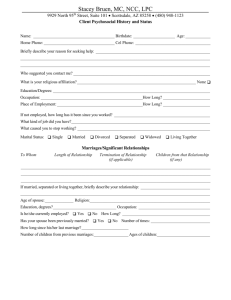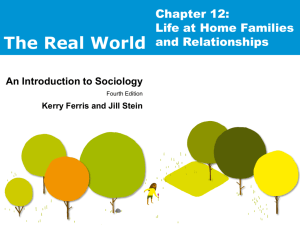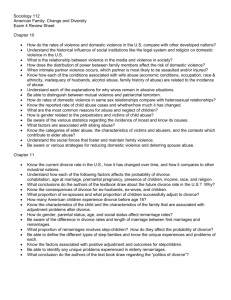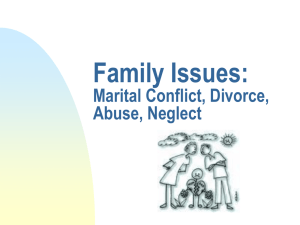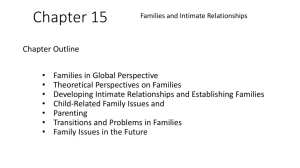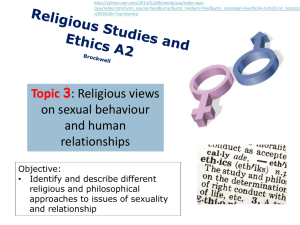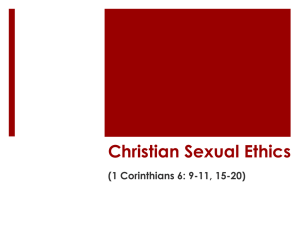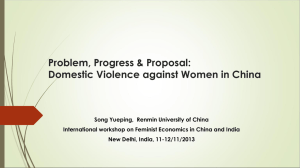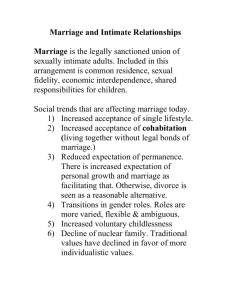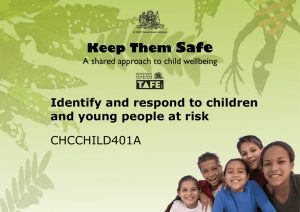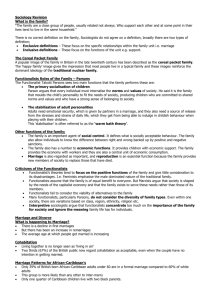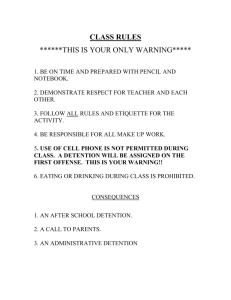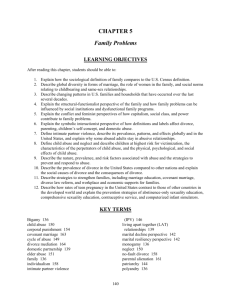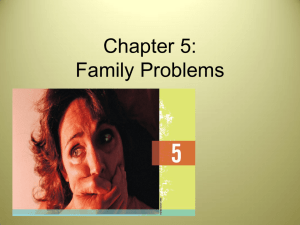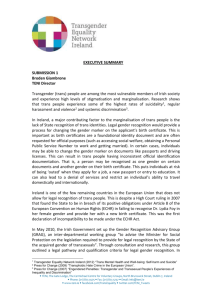slo 5 family - kellymeliasblog
advertisement
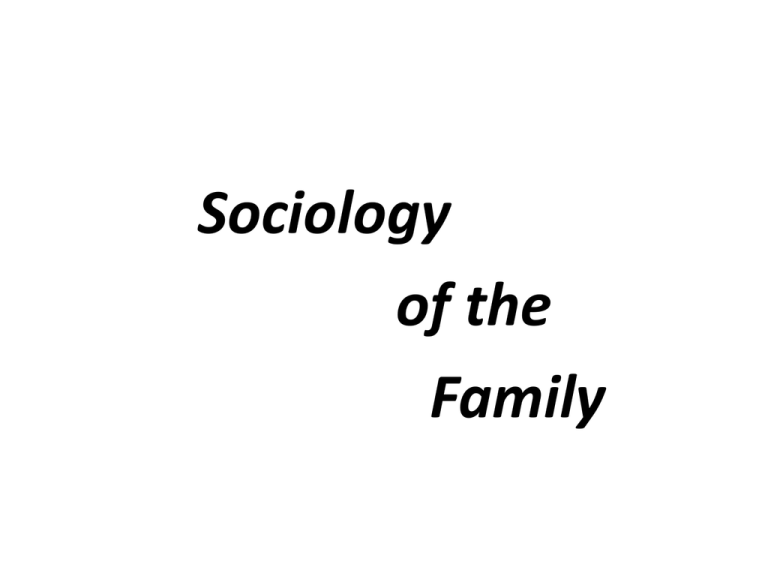
Sociology of the Family The Family The family is a area of great interest to sociologists especially when set in comparative context over time and culture. Our understanding of the family has increased over time as changing patterns have emerged and the its role within the wider society. The Family The Family in Ireland has being defined as ‘an important symbol of collective identity, unit and security’ (O’Connor, 1998: 89). People’s conception of the family has changed with time as research, discussion and enquiry have brought new information to the fore. Cont., “The family is an intimate domestic group made up of people related to one another by bonds of blood, sexual mating, or legal ties” (Scott & Marshall, 2005: 212). It has and to this day being very resilient social unit that has survived and adapted through time. Cont., The family is a basic and important institution in society, because at the end of the day it is where society is reproduced in it’s basic form, the individual. Family patterns have undergone rapid change over the past several decades Family Types • The extended family: Consists of parent(s), children, plus other relatives. • The nuclear family: Consists of two adults living together in a household with their own or adopted children. Live in a unit that is separated from the wider family Cont., • The reconstructed family/step family: Consists of two people who have children from previous relationships and who are now married or live together and each bring their children to live together with the new children they may decide to have. Families, therefore are linked by kin connections Marriage Defined Marriage can be defined as ‘legally sanctioned relationships, involving economic cooperation as well as normative, sexual activity and childbearing, that people expect to be enduring’ (Macionis and Plummer 2002: 436) Perspectives of the family Functionalists view of the family This approach believes that families perform vital functions for their members and for society. These functions include: 1. 2. 3. 4. Socialisation Regulation of sexual activity Social placement Material and emotional security kinship ties are ‘connections between individuals through marriage or through lines of descent that connect blood relatives’ (Giddens 2001: 173) 1. Monogamy- one man married to one woman 2. Polygyny- one man married to several women 3. Polyandry- one women married to several men (O’Donnell 2002: 36) Power relations Families can and will be classified by power and on lines of descent Power • Patriarchal: wealth and power come from the father and he controls the family. • Matriarchal: the mother controls the family • Egalitarian: Authority in the family is more or less equal Criticisms of functionalist perspective 1) Children are socialised outside the traditional family 2) People have sexual relations outside the family 3) Evidence of violence and abuse within families- Dysfunctional place 4) This perspective minimises the problems of family life Conflict theory Class based analysis of family This perspective views the family as another institution that is involved in “promoting dominant societal values and perpetuating the exploitation of subordinate groups by upholding the norms and values of capitalist society” (Marsh 2000: 554) Marx studied and analysed the role of families in the social reproduction of inequality - Socialisation of children, race and ethnicity Cont., Through the socialisation of children, the family produces the labour power and a false ideology which keeps the capitalist system going. This is summarised by Macionis and Plummer when they suggest that “Families thus support the concentration of wealth and reproduce the class structure in each succeeding generation” (2002: 440) Cont., Patriarchy: families transform women into the sexual and economic property of men. Women perform unpaid labour in the home that would otherwise cost a lot to those who benefit from it. Family The female-carer unit is the foundation of the single-mother family, the two-parent family, and the extended family in its many forms. Thus it is certainly the basis of family household life in Britain today, and is a phenomenon, even since preindustrial farmsteads and communes, we know that female carers predominate. Sheeran, 1993 Family I would argue that gay or lesbian households that consists of intimate communities of mutual support and that display permanent shared commitments to intergenerational nurturing share the kinship bonding we observe and name as family. Callahan, 1997 Feminist approaches-family They focused on the presence of unequal power relationships within the family and on showing that certain family members tend to benefit more than others. Cont., Feminists highlight the continuing exploitation of women in capitalist societies, not least in terms of the way in which their contribution to the bulk of the private domestic work remains unrecognised, unrewarded and undervalued labour” (Marsh 2000: 552). Cont., They argue that within the family structure, the women have little decision making autonomy, housework, looking after children, the sick and the elderly (Finch 1989) Feminists suggest that certain problems are overlooked by researchers such as ‘wife battering, martial rape, sexual abuse of children’ have longed being ignored (Giddens 2001: 177) Feminist Perspective 1. Importance of women within the domestic unit 2. Changing attitudes to and the roles of women in the areas of marriage, divorce and cohabitation 3. Significance of women’s roles as carers within the community (Marsh 2000: 554) Criticism of feminists The growing trend towards equality in decision-making between women and men More researching done by women rather than a man’s point of view Family structure in Irish society Structure and nature of the family unit has undergone major changes over the years. In particular, most men and women that are not working outside the home, tend to have more traditional views in relation to the family. Modern society the family have transferred to other institutions crèches, nurseries and pre-schools Shift in family structure • 15% lone parents • 4/5 headed by women • 28% lone parents were from separation and divorce • Decline in the marriage rate • Later age in marriage • Smaller completed family size • Increase in number of people remaining single Major changes resulting in: • Modernisation of Irish society • Decrease to religious regulations • Changing attitudes of women ‘Ireland like many other western countries, has seen a major change in the nature and structure of the family unit in recent times’ (Ibid 2003: 245) Divorce in Ireland • Introduced to Ireland, by the Family Law Act, 27th February 1997 • Before this Ireland only E.U. country to forbid civil divorce • November 1996, the people of Ireland voted in favour of divorce Divorce is the last option for most couples, however, it is a realistic and accepted part of life in twenty-first-century Ireland Cont., The following statistics support this fact: • February 1997- December 2001, 10,182 divorces granted in Circuit Court • 83 more granted in the High Court • Applications rose from 8,028 to 23,452 • In 2001 almost 3,500 applications were received • Over 60% were women Patterns and Reasons Violence ‘The true number of violent episodes that occur in homes up and down the country, as it remains is a largely a “hidden problem”, taking place behind closed doors, often with no witness present’ (Sclater 2000: 445) Cont., Only in the 1970s that violence against women and children was recognised as a social problem. It was difficult to estimate the true picture (extent), whereas also difficult to report Happens across all social classes Cont., Importantly, men also victims of domestic violence, however the majority of research states that women suffer violence on a larger scale. • 12 barring orders granted a week in Dublin alone • 65 women murdered in Ireland between 1996 and 2002 Cont., • Wife/mother responsible for care of the children • Housekeeping duties, areas of farm work • Different roles of husband and wife meant the family lacked emotional depth • Arranged marriages & matchmaking Family and Social Care 1. The Domestic Violence Act 2. The 1987 Status of Children Act 3. The 1988 Adoption Act 4. The 1991 Childcare Act These acts give the state the right to intervene and to take action to protect children and families. Agencies involved • Department of Justice, Equality and Law Reform/Gardai • Department of the Environment and Local Government • Department of Social and Family Affairs • Department of Health and Children • Barnardos Child and Family Services • ISPCC Abuse Sexual abuse highlighted only since the 1980sfull extent unknown • 1995, 6,415 reports of alleged child abuse • 1/3 confirmed cases ‘Child abuse statistics show that the number of cases that have been reported to the health boards have more than doubled between 1992 and 1999’ (Donohoe and Gaynor 2003: 213) Child Abuse According to the Child Care Act (1991) a child is ‘a person under the age of 18 years other than a person who is or has been married’ (cited in Richardson 1999: 170) Abuse of children can be in different forms: Physical, sexual, emotional, neglect. Summary The family is an important social institution which helps hold society together . Sociologists main interests in family includes: • Site of socialisation • Structuring basis of society • Influence in social policy issues (www.pshare.com)
